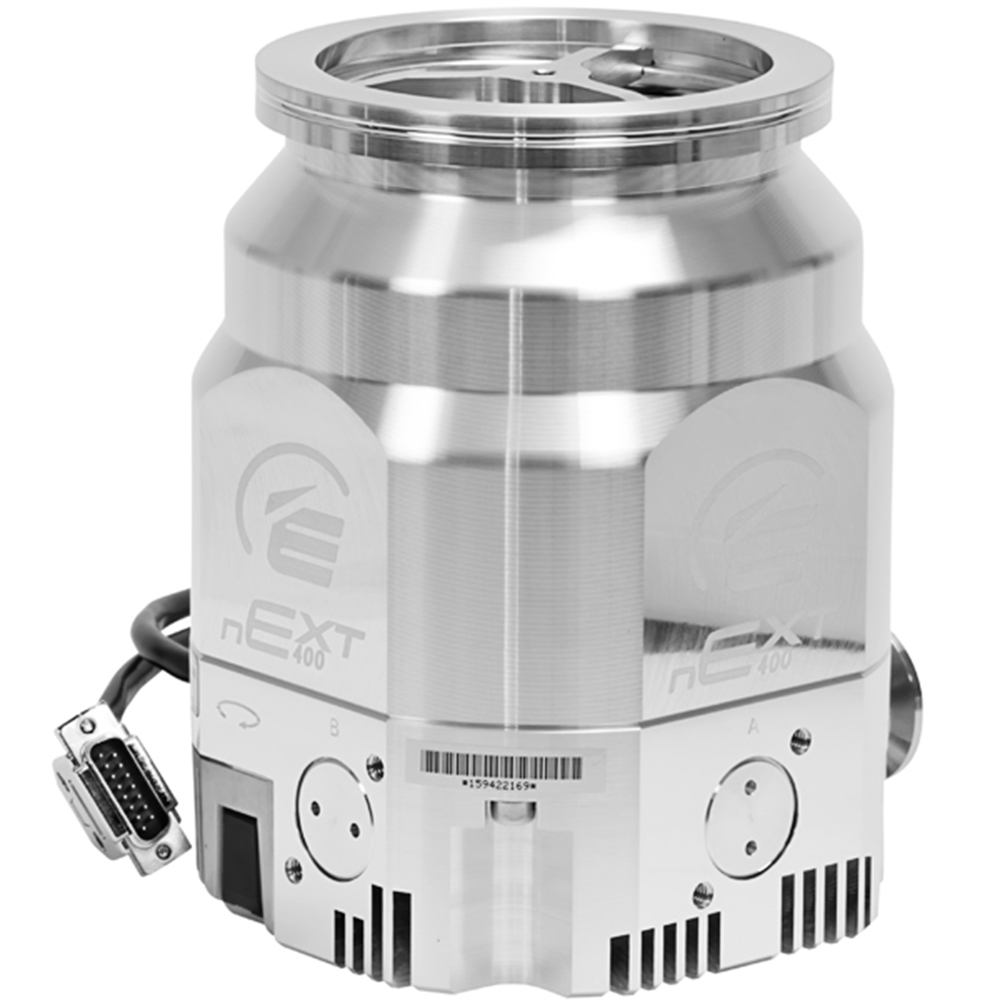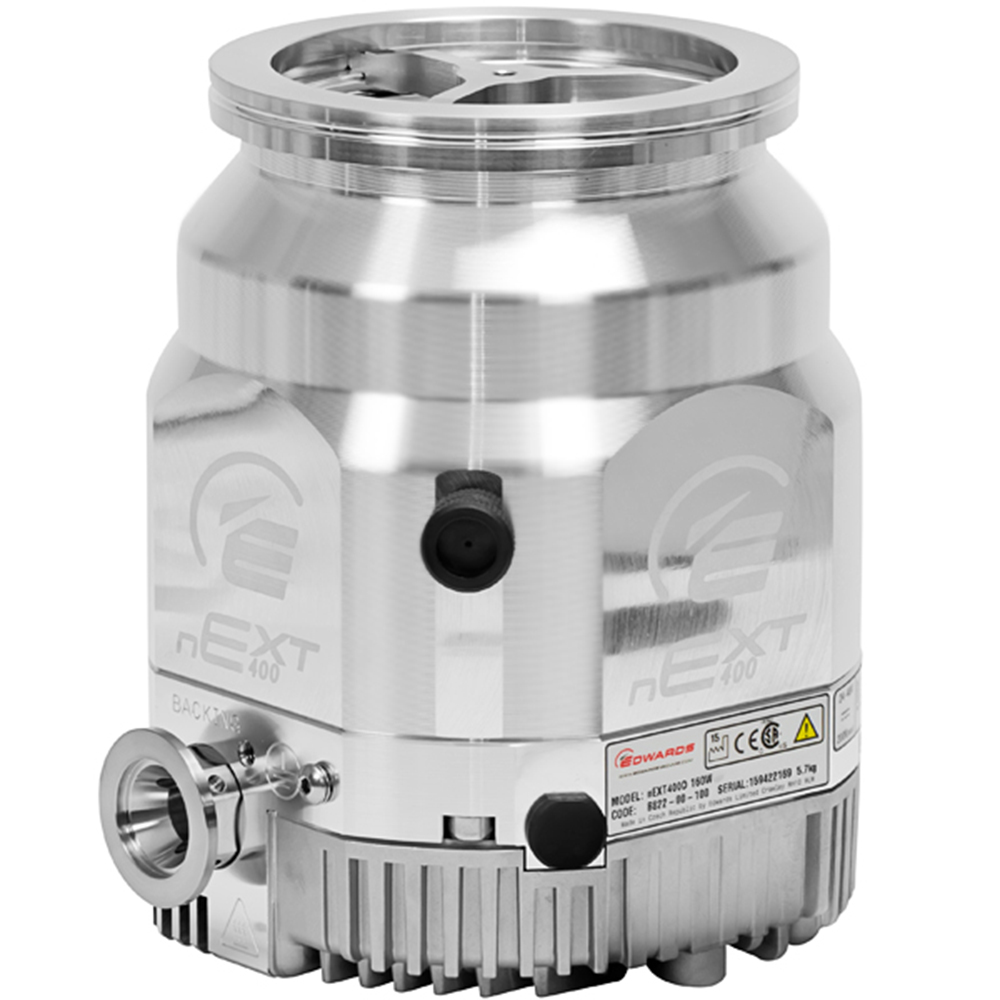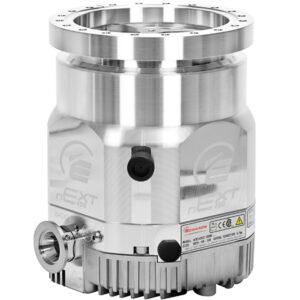Edwards nEXT400D Compound Turbomolecular Vacuum Pump, 400 l/s, ISO-160 Inlet, 160 Watts, B83200300
- MASS SPECTROMETRY: GCMS, LCMS, ICPMS,MALDI inorganic MS, RGA, surface science,leak detectors
- WHERE nEXT IS FITTED: TEM, SEM, SPM,sample prep benches
- RESEARCH & DEVEL OPMENT: Chamber evacuation, coating systems, turbopump systems
- HIGH ENERGY PHYSICS: Beam Lines, accelerators, mobile pump carts, turbopump backing, laser evacuation, medical systems
- SERIAL COMMUNICATION CONTROL: available with RS323 and RS485 (Windows softwar eincluded)
- INDUSTRIAL: Glove boxes, coating systems, XRD/XRF systems, lamp evacuation
- SEMICONDUCTOR: Load locks and transfer chambers
- SOLAR: Photovoltaics, solar thermal technology
$11,003.46 $13,754.32
This listing is for the new Edwards nEXT-400D hybrid bearing compound turbomolecular vacuum pumps, operates on 24 to 48 VDC, 80 Watt version, for use with 100 or 200 Watt TIC controllers, reduced start up time to full speed, pumping speed of 400 liters per second (l/s) of nitrogen, ISO-160 inlet flange, ISO KF-25 exhaust foreline flange, pump to controller cable attached (1 meter) with Edwards part number B832-00-301. A basic pump system would require a Edwards nEXT400D pump, a TAG or TIC controller, either an air or water cooling accessory and a suitable backing roughing pump. The complete specifications and application brochure in PDF format can be downloaded below.
The Edwards nEXT400D is a hybrid bearing compound turbo pump and available with either ISO-160 or Conflat 8 inch inlet flanges and have a pumping speed of 400 l/s of nitrogen. The nEXT pumps combine Edward’s proven bearing technology (oil lubricated ceramic lower bearing with dry permanent magnetic upper bearing), with improved rotor design and a new molecular drag stage to deliver improved pumping speeds, compression ratios, and true user serviceability. They feature 24 to 48 VDC sensor less motors with a built in drive that is fully compatible with the range of TAG and 100W and 200W TIC controllers. They are available pre-set for either 80W or 160W maximum power, the 80W pumps can be used with the Edwards 100W TIC controllers for low power applications but will require a longer ramp time to full operating speed.
User Friendly Maintenance Technology
The new Edwards nEXT technology have enabled the pumps to be serviced in the field. An interim oil lubrication change can be performed, where access allows, in-situ, typically in less than 5 minutes with the minimum of specialist tooling. A bearing and oil lubrication service, with minimum disassembly can be performed in less than 10 minutes using basic workshop tools and an Edwards tool kit. The nEXT pumps will advise the user when a service is due and what level of intervention is required. The request for service is by a simple flashing LED sequence on the pumps, and by serial communication notification.
| nEXT240 | nEXT300 | nEXT400 | ||
| Inlet flange | DN100 ISO-K or DN100CF | DN100 ISO-K or DN100CF | DN160 ISO-K or DN160-CF | |
| Inlet pumping speed (l/s) | N2 | 240 | 300 | 400 |
| He | 230 | 340 | 390 | |
| H2 | 165 | 280 | 325 | |
| Compression ratio (D) | N2 | >1 x 1011 | >1 x 1011 | >1 x 1011 |
| He | 3 x 105 | 1 x 106 | 1 x 108 | |
| H2 | 1 x 104 | 5 x 104 | 5 x 105 | |
| Compression ratio (T) | N2 | >1 x 1011 | >1 x 1011 | >1 x 1011 |
| He | 1 x 106 | 3 x 106 | >1 x 108 | |
| H2 | 1.5 x 104 | 1 x 105 | 1 x 106 | |
| Interstage pumping speed (l/s) | N2 | 13 | 13 | 13 |
| He | 13 | 13 | 13 | |
| H2 | 11 | 11 | 11 | |
| Backing/interstage/boost ports | NW25 | NW25 | NW25 | |
| Vent/purge port | 1/8” BSPP | 1/8” BSPP | 1/8” BSPP | |
| Critical backing pressure (D) (mbar) | 9.5 | 9.5 | 10 | |
| Critical backing pressure (T) (mbar) | 20 | 20 | 20 | |
| Maximum continuous inlet flow (nitrogen, sccm) | ||||
| Water cooling (40°C ambient) | 45 | 95 | 105 | |
| Forced air cooling (35°C ambient) | 30 | 115 | 90 | |
| Natural convection (30°C ambient) | 10 | 35 | 45 | |
| Maximum system flange temperature during bakeout (CF only) | ||||
| Water cooled/forced air cooled | 120 / 115° | 120 / 115° | 120 / 115° | |
| Maximum continuous backing pressure (mbar) | ||||
| Water cooling (40°C ambient) | 6 | 6.8 | 7.5 | |
| Forced air cooling (35°C ambient) | 4.8 | 7 | 7.5 | |
| Natural convection (30°C ambient) | 1 | 2.8 | 4 | |
| Recommended backing pump* | RV12/nXDS10i | RV12/nXDS10i | RV12/nXDS10i | |
| Peak booster speed m3h-1 (T variants) | ||||
| RV12 | N2 | 26 | 26 | 26 |
| nXDS10i | N2 | 24 | 24 | 24 |
| Normal rotational speed (rpm) | 60000 | 60000 | 60000 | |
| Start time to 90% speed (sec) D (T) | 115 (150) | 145 (190) | 180 (210) | |
| Sound pressure level at 1 m (dBA) | <45 (+/-3) | <45 (+/-3) | <45 (+/-3) | |
| Mass (kg) D (T) | ISO | 5.7 (6) | 5.7 (6) | 6.5 (6.8) |
| CF | 8.8 (9.1) | 8.5 (8.8) | 9.5 (9.8) | |










